AmmoLand Editor Jim Grant reviews the SIG MCX Virtus Pistol to see if it holds up to the hype and the price.
U.S.A. -(AmmoLand.com)- As a younger man with infinitely more free time, I was obsessed with whatever latest and great caliber/gun/optic came out. I would drool over pixelated videos of SHOT Show longing to attend and dreaming of a day when I could afford such marvels of modern engineering.
But as a poor college student, I would reason to myself that these high-ticket firearms weren’t worth the cost of admission. That their advancements were too minor to justify the difference in price between them and more budget-friendly AR-15s like those from Palmetto State Armory.
Then one day this all changed. I happened upon a smoking deal on a piston-driven SIG carbine at a pawn shop right before a two-day rifle clinic and barely had the chance to zero it before the class.
I showed up to the class with my match-grade pre-ban Bushmaster A2 HBAR and was loving it thoroughly… until South Carolina’s infamous splash-and-dash torrential rains intervened. Suddenly my ultra-precise tac-driver turned into an awkward single-shot front-heavy nightmare.
Frustrated as hell, I finished the first day of class more proficient as clearing malfunctions than shooting. While cleaning my rifle, I remembered that SIG I’d just bought the other day, and decided that anything was better than the HBAR – especially with heavy rain forecasted for the second day of the class.
So I loaded up all my mags with cheap steel-cased ammo, changed the batteries in my EoTech holo sight, and headed out the following day.
With visibility limited to roughly 15 yards, the heavy rain wreaked havoc on my fellow classmate’s carbines. Short-strokes, failures to eject, and double-feeds surrounded my SIG 556 Commando carbine. But the chunky SIG just kept chugging through the mix of Brown Bear, Silver Bear, and Tula 223 ammo.
While the gun barely produced groups below 3 MOA and threw spent casings into the stratosphere, the gun never malfunctioned once. I was smitten.
So when SIG announced a lighter, more ergonomic design that relied on an equally reliable, but less violent short-stroke piston, I knew I had to get my hands on it.
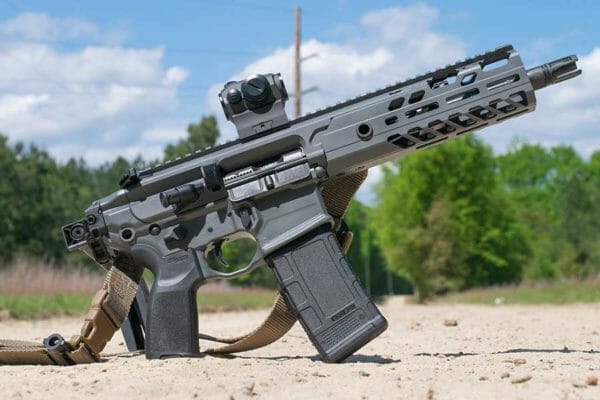
Enter the SIG MCX Virtus Pistol
The Virtus is the second generation of the SIG MCX pistol/carbine/SBR. It utilizes the same short-stroke, gas-piston driven action of the MCX, but with a nice Cerakote finish in either gray or FDE.
One of the things I enjoy the most about the MCX is that it takes the biggest advantages of piston-driven firearms, and marries it to the top-notch ergonomics of the AR-15. But unlike piston conversions for the AR, the MCX isn’t overly nose-heavy – especially when in a pistol configuration. The two models I reviewed were the original 5.56 Virtus with an 11.5in barrel, and the newest MCX Virtus with a 9in barrel chambered in .300blk. While both are fairly light (the 5.56 weighing in at 7.4lb and the .300blk at 7lb respectively), the shorter barrel on the .300 blk version made for a much more balanced package -especially with a sound suppressor installed.
Short-Stroke VS Long-Stroke Pistons
In a traditional long-stroke piston system like that on an AK, the gas piston is fixed to the bolt carrier. When the gun fires, some of the gas is siphoned off and presses against the piston head/bolt carrier assembly and forces it rearward.
There’s a lot of mass moving inside the gun which means a good deal of momentum and generally positive, reliable functioning. The downside is that the extra mass tends to give the guns more felt recoil and be relatively heavy.
Short-stroke piston guns function much the same way, except the piston isn’t attached to the carrier. Instead, it’s normally captured with a return spring forward of the action. (though not always) which means less reciprocating mass inside the gun, which in turn results in less felt recoil. A very common example of this is the Soviet SKS carbine.
Another advantage of short-stroke pistons is that they tend to affect the barrel’s harmonics less than a long-stroke one because the action’s movement is less violent. This means that in general, short-stroke firearms tend to be more accurate than long-stroke ones. But of course, ammunition, barrel profile and shooter skill play equal roles in this.
But before we get into the performance of either gun, let’s get a full run-down of all the features starting at the muzzle and going all the way to the brace at the rear.
SIG MCX Virtus Features
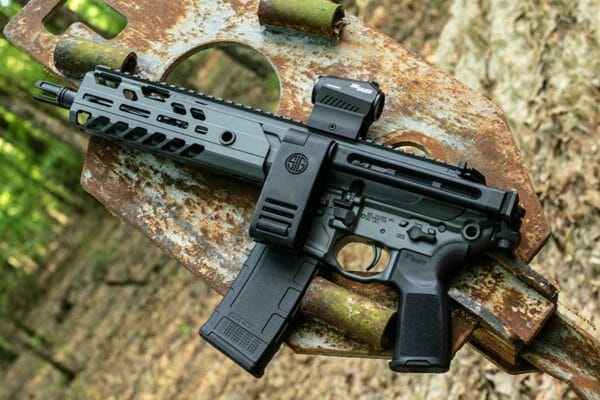
The MCX is a very distinct-looking firearm. And this is apparent even at the muzzle. Both the .300blk and 5.56 models feature a unique, tapered three-pronged flash-hider with a deep semi-glossy black finish.
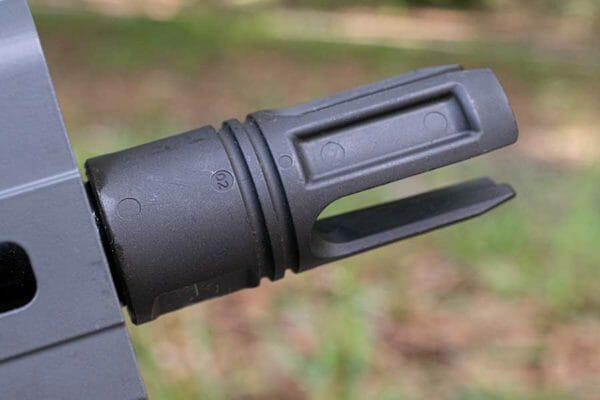
The Vietnam M16A1-esque open flash hider proved extraordinarily effective at mitigating muzzle flash with both the .300blk and 5.56 cartridges. Under the flash-hider, the MCX lacks a proper barrel shoulder and instead utilizes a tapered design that slopes from the gun’s medium-contour barrel to one of two different thread pitches depending on the caliber of the gun. For the 5.56 model, the MCX has a standard 1/2x28in thread pitch, while the .300blk uses the 30-cal standard 5/8x24in.
While the tapered muzzle works great with SIG-designed muzzle devices and suppressors, shooters looking to run their own brand of sound-suppressor should invest in a tapered collar to reduce the chances of a baffle strike. Though in testing, I personally never used a collar, and I never had any issues whatsoever. But given the low cost of said collar, it’s worth the added insurance.
Handguard

Continuing rearward, the next thing shooters will notice is the MCX’s rectangular/oblong handguard. Built from ultra-rigid 6061 extruded aluminum, the handguard feels like it could take hundreds of pounds of force without giving an inch.
The hardy rail features a fully numbered Picatinny rail on top, with M-Lok mounting slots at the three, six, and nine o’clock positions. These are ideal for shooters looking to mount lights, lasers, or angeled foregrips on their pistols. But since the ATF considers this a pistol, shooters should avoid mounting vertical grips to prevent NFA-compliance legal woes.
Other features include heat venting cuts every 45 degrees between the mounting slots. At the very front of the handguard, the rail features a cutout that allows access to a gas selector valve that looks like a futuristic tuning fork.

A simple turn of this toggles between minus and plus settings. The minus setting siphons less gas from the cartridge for shooters utilizing a sound suppressor to prevent over-gassing the carbine. While the plus setting uses more gas and is ideal for using the MCX without a suppressor installed.
Further back, the Virtus features a pair of ambidextrous QD sling mounts, and behind these, the carbine features a unique interface for attaching to the MCX receiver. Whereas most AR-15 handguards utilize the barrel nut (or a modified delta ring or equivalent) the MCX utilizes a hex screw and a hooked pin that is secured to the receiver when the forward takedown pin is inserted.
This might seem odd, but the benefit of it is that the handguard can be removed from the carbine in less than ten seconds and with only the use of a hex key.
Barrel and Receiver
Another component of the Virtus that can be swapped out with just a hex key is the barrel itself. Secured to the receiver with two thread-locked large machine bolts, a shooter can remove the combination barrel/piston assembly in just a few seconds.
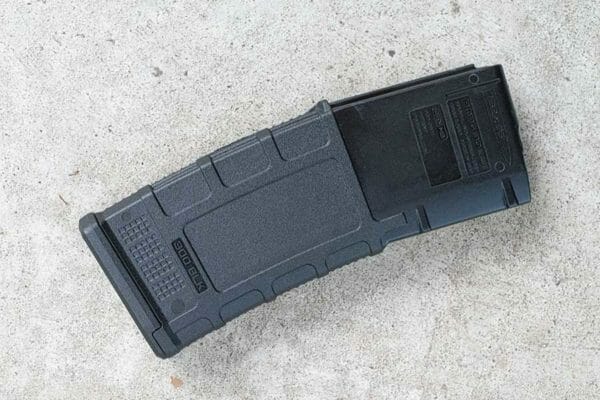
If this quick-change barrel capability seems odd given that the SIG MCX Virtus Pistol isn’t an LMG, it’s because one of the original big selling points of the carbine was its ability to quickly change calibers. Unfortunately, since the barrel, piston, and gas block are a single unit, caliber swaps aren’t cheap – even if they are very quick.
Still, cheap is relative. Especially when dealing with products from a high-end gunmaker like SIG. Even if the cost of the so-called, “caliber X-Change Kit” is higher than many would prefer, it is still only a fraction of the price of a new firearm.
Barrel Performance
But back to the barrel for a moment. I had the chance to test out both my personal MCX Virtus in 5.56mm and the review gun in .300blk, and both proved very accurate at the somewhat limited ranges they were evaluated at.
With SIG’s Premium Match-Grade 77gr 5.56mm rounds, the 11.5in barrel consistently produced just barely sub-MOA 10-round groups. The number hovered right around 0.90 inches, but some groups shrunk as small as 0.75in. The largest group of the day occurred after some rapid-fire video work and grouped just a hair over MOA at 1.13in. Not bad for a short-barrel piston gun.
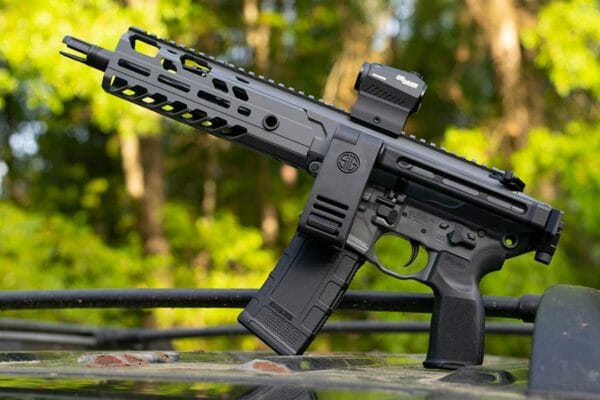
What about .300blk from the stubby 9in barrel?
Fired from a Lyman rest, the .300blk Virtus churned out similarly impressive groups, with the best measuring roughly 0.75in at 100 yards. The average seemed to be a little higher than with the 5.56mm Virtus, but only by about 0.1in.
Aren’t shorter barrels less accurate?
Yes and no. In terms of practical accuracy and within the effective range of the tested calibers from the relatively short barrels – no. But, at extended ranges is where things would get dicey.
With rounds like 5.56mm that are designed to be fired from longer barrels, they lose velocity which leads to the round become trans-sonic and subsonic at closer distances. Which in turn leads to the round being destabilized sooner, and thus has a less consistent point of impact. But the SIG MCX Virtus Pistols are pistols. They aren’t designed to be shot at 500 yards.
Ergonomics
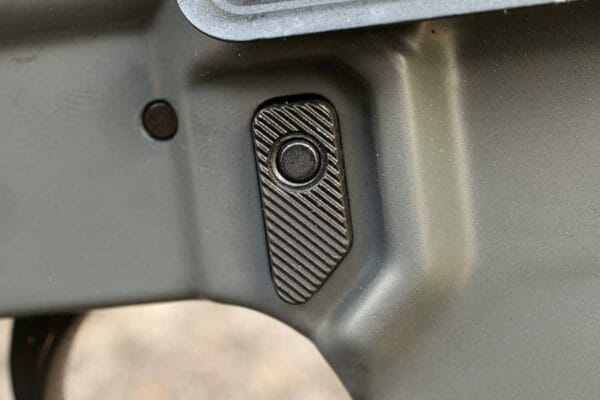
Continuing back, the receiver on the MCX Virtus is reminiscent of an AR-15’s, but is clearly different. While it still features the iconic forwards assist and fire-selector, this is no AR derivative.
The controls are fully ambidextrous, the trigger guard is integral to the receiver and the non-reciprocating charging handle is somewhat abridged in comparison to an AR’s. But unlike mil-spec ARs, this charging handle is ambidextrous. Though in testing, I would recommend purchasing an over-sized one like those from Radian Weapons as it makes charging the weapon much easier.
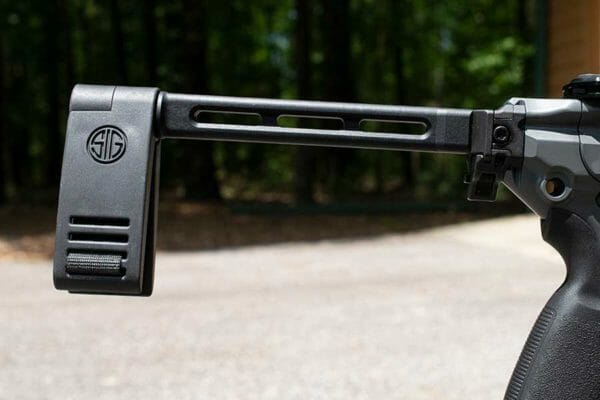
Under the magazine release button, the magazine well of the MCX features a slight flair for easier reloads. The magazines themselves should look familiar to most shooters, as they are simply STANAG-pattern AR-15 magazines. Both the 5.56 and .300blk versions include a single Magpul 30-round PMAG with the gun, with the .300blk version featured a specially marked (but otherwise identical) PMAG.
Finally, the rear of the receiver features a Picatinny rail for attaching either a brace, or a stock (in the case of a full-sized gun, or an SBR) of a shooter’s choice. The newer model Virtus pistols ship with a skeletonized, low-profile brace that features rotating rubber clamps at the rear. These are designed to allow shooters of all sizes to adjust the brace to better fit them.
SIG MCX Virtus Pistol the Pros & Cons
Now comes the fun part where we tear down the gun and talk about all the stuff we hate about it! OK, not really, but there are a few aspects of the Virtus that could stand a little improvement.
First off, with an MSRP over $2,000 I would really like the gun to include some form of iron sights. I know there are dozens out there for cheap money, but it always hurts a little when dropping big bucks on a gun and having it technically unusable out of the box. Yes, the same could be said of ammunition, but no one realistically expects ammo to be included with a gun.
The other gripe I have with the SIG MCX Virtus Pistol is the amount of play in the charging handle. I really like the design, and it’s very reminiscent of my all-time favorite pistol caliber carbine – the MPX. But like the MPX, the charging handle has a decent amount of vertical play in it which can increase the amount of friction between it and the receiver to the point of potentially inducing a malfunction.

SIG could remedy this with either a spacer or a redesign of the charging handle itself – with the former being a vastly cheaper solution.
But enough nick-picking, how did I like the gun?
While I’ve only fired 150 rounds through the .300blk version, I’ve put two cases through my 5.56mm Virtus both suppressed and unsuppressed, and I’ve never had a malfunction with any type of ammo. This includes bottom-of-the-barrel Monarch lacquer-case .223, and older Barnaul ammo that was visibly rusted. Despite the ability to just chew through any garbage-rounds I fed it, the Virtus still produced excellent groups with quality ammo.
Virtus Verdict

Is SIG’s over-built piston-powered-pistol worth the extra dough over an AR-15? To the majority of shooters, probably not. Most guys never fired their AR-15 more than 100 times in their life. But for shooters out there that run their guns hard or suppressed and rely on their gun for serious use – yes, 100%.
The SIG MCX Virtus Pistol puts up with my extremely negligent cleaning habits and keeps on ticking. It isn’t the budget-blaster with cut corners at every turn. It’s a tough-as-nails AK-tier-reliability firearm with the ergonomics of an AR-15, and the accuracy shooters expect from high-end brands like SIG. Personally, I love these guns. And no, I’m not just Virtus-signaling.
About Jim Grant
Jim is one of the elite editors for AmmoLand.com, who in addition to his mastery of prose, can wield a camera with expert finesse. He loves anything and everything guns but holds firearms from the Cold War in a special place in his heart.
When he’s not reviewing guns or shooting for fun and competition, Jim can be found hiking and hunting with his wife Kimberly, and their dog Peanut in the South Carolina low country.


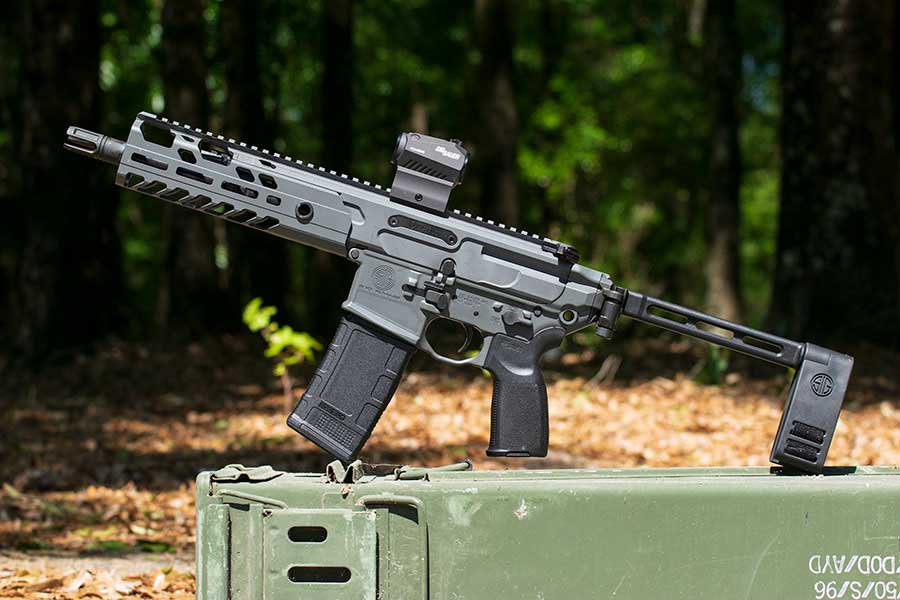

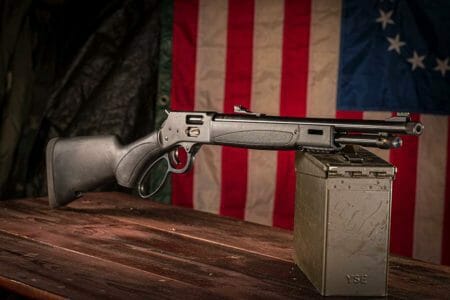
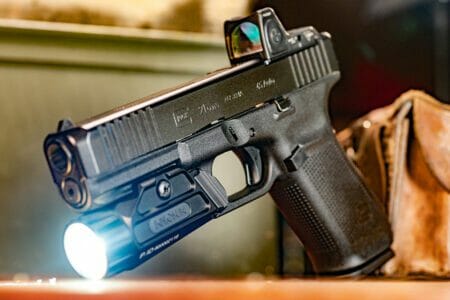

I wish Ammoland would do away with the annoying pop-ups promoting this and other giveaways. The original article and the little ad at the top of the home page are quite sufficient to generate awareness of this promotion.
The unnecessary pop-up that blocks the whole page from one to three times each viewing is uncalled for and does nothing to generate interest.
That’s the new American internet business model, developed by twenty-something computer whiz-bangs who have marvelous computer skills but whose sales experience is limited to “do you want fries with that?”.
The idea seems to be “annoy the customer until they buy something”.
OR they just stop visiting the site…Yeah the ads brought to you by then 20 something whiz-bangs that continually asked as kids, ARE WE THERE YET, till the vacations were stopped….
On the other hand AMMOLAND is probably paid by the advertisers, thus giving us the great site cost free.
Author states “The controls are fully ambidextrous” but they are not, it only has a left sided bolt release/lock.
With ammo shelves bare and online prices sky high, we might as well spend on quality arms and optics until the panic ammo buying is over. And if you are a regular shooter, the cost of the gun is the smallest of the three.